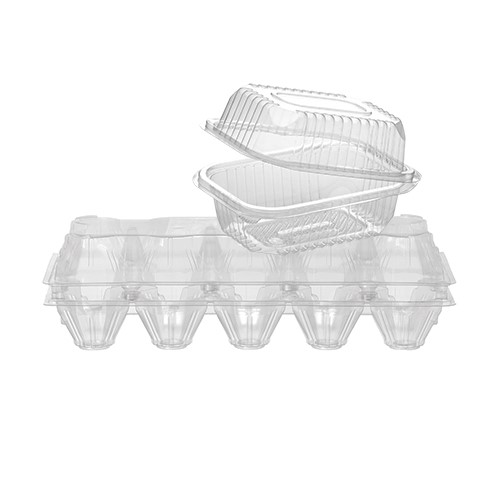
Clear Plastic Clamshells
Depending on your recycling processor, some communities can recycle clear plastic clamshells (produce, bakery, eggs). Clamshells should be empty, clean and dry.
Beginning November 1, 2024, some local recycling processors are accepting clear plastic clamshells for recycling.
What is a clear plastic clamshell?
A clear plastic clamshell is a hinged container for fruit, berries, produce, deli, salad, bakery, eggs, and carry-out food.
Clear plastic clamshells must be empty, clean, and dry before recycling. Make sure the clamshell is closed before recycling.
No Styrofoam or paper clamshells. Do not include Styrofoam or paper clamshells, packaging, cups, trays, and food containers. These items are not plastic clamshells and should be placed in the trash.
Which recycling processors can accept clear plastic clamshells?
Beginning November 1, 2024, Rumpke Waste & Recycling accepts clear plastic clamshells for recycling in Cuyahoga County. If your community is serviced by Rumpke, you can recycle clear plastic clamshells. Improved optical scanners and AI allow Rumpke to separate the plastic clamshells from other plastics. See Rumpke's information about adding clear plastic clamshells to recycling.
Currently, Kimble Companies, Republic Services, and WM do not accept plastic clamshells for recycling.
Find out which recycling processor serves your community by allowing location services or using the green ‘Select a City’ drop-down at the top of every page and clicking ‘See Details.’
What about other plastics? Can all plastics be recycled?
In Cuyahoga County, all communities can include plastic bottles or jugs in curbside recycling. Plastic bottles and jugs must be empty, clean, and dry before recycling. The container should have a “neck” and have a diameter larger than 2". See more about plastic bottles and jugs.
Some communities can include plastic tubs and plastic to-go cups in recycling. See details about managing other plastic.
What is the chemical recycling process for plastic clamshells?
Plastic clamshells are accepted and processed by Rumpke Waste & Recycling. The material is sorted then baled and shipped to Eastman Chemical in Tennessee.
The material is cleaned and shredded at Eastman Chemical. Any non-PET material is removed through a float sink process, then the PET is fed into the system where methanolysis, a process using heat and pressure and the removal of oxygen, breaks the PET back into a hydrocarbon.
The liquid oil produced is turned back into a solid and then pelletized into a post-consumer PET pellet. The PET pellets become new products such as colored PET bottles and eyeglass frames.
Earth911 explains the difference between PET plastic bottles and PET plastic clamshells.
Why is recycling plastic so challenging?
There is an abundance of plastic packaging in our society today. Currently, about 9% of it can be recycled. This is due to limited markets for recycled plastic - not all manufacturers produce packaging from recycled plastic - and the complexities of sorting, processing, and recycling the various kinds of plastic.
Plastic is a synthetic (man-made) material. Most plastic material is a derivative of crude oil and natural gas, which are non-renewable resources. Plastic products are often a polymer resin mixed with a blend of additives.
Plastic products are created through thermoforming and blow molding. Earth911 explains the differences between the processes including how they are chemically different and melt at different temperatures, and how that affects recyclability.
Most plastic placed in curbside recycling bins is downcycled. This means it is turned into lower-quality products such as fibers for clothing, carpeting, polyfill in pillows, winter coats, and other goods. Only a small percentage is recycled into new bottles and containers. Read more about downcycling.
NPR published a project in 2019 that explains plastic recycling.
What are our alternatives?
We can choose to reduce our consumption of single-use plastic. Small changes add less plastic waste to our landfills and our environment. Consider these ideas for reducing waste.
Until there is a major shift in the demand for recycled plastic and more sensible packaging design, consumers are limited in our recycling options.
---
Looking to recycle, donate, or dispose of other items? Use the dark blue 'What Do I Do With?' search bar at the top of every page of this website. Allow location services or use the city drop-down to find opportunities in your local area.
